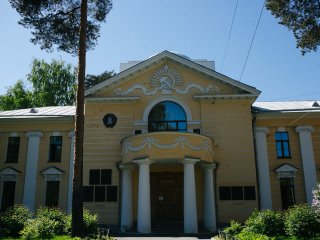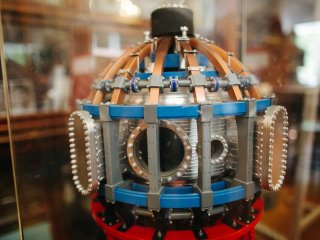The ball lightning looks like a luminous sphere which usually appears during thunderstorms. Such an object would often hang or move at a fixed altitude over the Earth’s surface. Sometimes, the ball lightning may explode either having come into collision with some object or without any apparent reason. It is interesting that there is still no generally accepted theory in global physics explaining the nature of this phenomenon.
Despite the centuries of investigations, the electric phenomena in the atmosphere of Earth still remains underexplored. The nature of fireball, even the very fact of its existence, probably represents one of the greatest mysteries in the world, doctor of physics and mathematics, senior research fellow at the Solid-State Theory Sector of the Ioffe Institute of Physic and Technology Mikhail Leonidovich SHMATOV believes. In the interview to Scientific Russia, the scientist highlighted the most interesting issues related to ball lightning.
─ It is true that the scientific community was not 100% sure about the existence of ball lightning until 2012, and the scholars started speaking about it as a real object only after the sensational discovery of Chinese scientists who had found iron, silicon and calcium in it? They have even suggested the fireball being a sort of hallucination caused by exposure to electromagnetic fields generated by conventional lightning, haven’t they?
─ Nothing fundamentally new was discovered in 2012, as the Chinese did not present any revolutionary data following the results of their observations. The question of whether they have really observed the fireball remains open. They are likely to have witnessed the consequences of conventional lightning hitting the power line (Professor Karl Stephan from the Texas State University, San Marcos and I have written about it in our joint survey). Sometimes, it is believed that they have detected the admixtures of iron, calcium and silicon in the fireball. However, the spectral lines of these elements are likely to have been registered due to impact of lighting discharge on the power line and ground, as the charge short-circuited the power line producing some effects. Let me remind you that it happened near the power line so the short circuit to ground might occur leading to such consequences.
However, the situation really looks challenging from the viewpoint of the idea that people have with regard to fireball. Many take interest in fireball, while there are specialists in plasma physics who know nothing about this phenomenon. This is the situation that we have today.
As for hallucinations, it is believed that in some cases people may seem to see some luminous spots due to a bright flash of light produced by conventional lightning. There was a paper saying that the magnetic fields produced by conventional lightning may make impact directly on human brain and lead to optical illusions of more complex origin.
Actually, a lot of long-living luminous objects exist, and they may be taken for fireball by mistake. A vivid example discussed in scholarly literature: in some cases, even a bird living in a hollow of tree trunk may be taken for fireball! The bird may be stained with rotting wood which gleams in some conditions.
As for the said observations of Chinese scientists the results of which were published in their article, I believe that the situation was the following: they might see the consequence of the lightning stroke, instead of fireball.
Yes, there are those who either know nothing about fireball or believe it to be an optical illusion, yet it is known for a fact today that the fireball exists. We know it from the articles highlighting the destructive effects caused by this phenomenon.
─ There is no general consensus so far as to what the fireball consists of. What is your version?
─ You are right. There are only various assumptions and models. I believe that the fireball consists of electrons and almost completely ionize ions (actually nuclei) of elements being part of the air, i.e., the presence of silicon and other mentioned elements is not required.
My model is based on the assumption that the main part of fireball is a nucleus consisting of almost completely ionized ion and electrons oscillating relative to each other. It appears that electrons are oscillating relative to ions. Ions are also moving. The electrons are moving in radial direction, while the situation with regard to ions is much trickier and depends upon the specific parameters of nucleus. The nucleus is a plasma cloud like the ones that emerge during some experiments in laser thermonuclear synthesis and nuclear explosions in the atmosphere (though the reasons for oscillations are different there). Other scholars also studied model with oscillations, yet I am the only one to have managed to explain the period of life and energetics of the fireball within the framework of such a model.
Reference. In the said situation, ionization means extraction of one or more electrons. The extraction of all of them is the complete ionization, while the completely ionized ion of some element is its nucleus.
─ Fireballs have been known for thousands of years. Why has nobody ever managed to identify their nature?
─ I believe that the main problem lies in the fact that broadscale research with adequate financing is missing in this field.
Important studies devoted to fireball were carried out in the USA in the 1960s. They resulted in the publication of wonderful book The Nature of Ball Lightning by Stanley Singer. The investigations were carried out during the war in Vietnam, so the ultimate goal lay in scaring the hell out of the Viet Cong (i.e., the National Front for the Liberation of South Vietnam). I have learned about it after Singer’s death. Today, no such tasks are set, so the interest in ball lightning is moderate. Besides, the complexity of problem and absence of evident applicability deters many scholars.
However, I think that the studies of ball lightning are of substantial political importance for plasma physics, as we face a problem of energy production today, while the controlled thermonuclear fusion is one of the promising solutions for it.
The position of many scholars studying thermonuclear fusion is as follows: if adequate funding is allocated, the mankind will get this energy source, as plasma physics is quite clear. However, a question arises here: why do you believe that plasma physics is quite clear? Well, you have solved one or two problems, and it is good. Yet, there is such a natural phenomenon as ball lightning. It has been known for thousands of years and is related to plasma, but no one has ever managed to explain it. Until the nature of ball lightning is explained, we can hardly believe the plasma physics to be clear to us.
─ As far as I know, plasma is believed to be the most underexplored state of matter…
─ A tricky question. I believe that some expects in this area have been explored pretty well. Without thoroughly studied plasma physics, we could hardly invent the thermonuclear bomb. They spared no expenses on these studies, and we now have this bomb securing peaceful coexistence on the planet.
─ Can the ball lightning be generated in laboratory conditions?
─ I would say that there is no direct answer to this question. It would be more correct to say about generating it on the test range instead of laboratory. Why? As is known, the fireball is a manifestation of atmospheric thunderstorm activity. In some cases, a thunderstorm cloud can boast of tremendous voltage potentials. The voltage difference between different points of cloud, or a certain cloud point and ground may reach a hundred million volts. In some conditions, it may amount to several hundred million volts, or even several billion volts. That is why such studies should better be carried out in the conditions of a test range.
There have been numerous attempts to generate ball lighting at a laboratory. However, no convincing results have been reported so far. I cannot say whether it is possible or not. It is better to work at a test range within the framework of my model. Such experiments were carried out in the USA at least twice. The attempt was made to use lightning initiated by missiles tugging wire along. Yet, as you know, the rocket launch is a serious thing. These experiments were made at special test grounds of the National Guard. Such research is an expensive and dangerous project, as one may bring an airplane down with a missile in case of launch failure, or get under the blow of initiated lightning.
The experiments with the use of conventional lightning instead of missiles are also possible. There are very many reports about the conditions of observing ball lightning. For instance, one can reproduce these conditions and wait for the conventional lightning to strike. It is easy to recreate the condition for ball lightning generation, but I would not dwell upon the methods to do it now. The problems of high cost and safety precautions are crucial for experiments made without the use of missiles as well.
─ Our compatriot, Nobel Prize winner Petr Kapitsa also studied fireball lightning. He wrote that the fireball, being a phenomenon of rare occurrence, was hardly fit for exploration. What do you think of it?
─ It is not clear to what extent the phenomenon is rare. It is deemed that for a person living in the central part of Russia the probability of meeting with ball lighting during their lifetime amounts to about 5%. It is not much. However, an interesting survey was conducted in the USA in 1963. The employees of NASA were polled as to how often they had seen the ball lightning and observed a stroke of conventional lightning from a close range. Both groups turned out to be comparable in number. Thus, one can hardly speak seriously about the probability of fireball generation at the discharge of conventional lightning. The fact is that ball lightning features short detection range. Moreover, wise people usually stay inside during a thunderstorm. On the other hand, conventional lightning is visible from a long distance, as it is very bright and produces a strong sound. The frequency of ball lightning generation by natural charges is likely to be comparable with the frequency of conventional lightning. Thus, we can just fail to see fireballs.
As for the statement about the ball lightning being a rare bird, I do not consider it to be a serious obstacle for research, as a tremendous volume of observation data has been accumulated, though we obviously cannot trust all of the messages.
The number of people having seen the conventional lightning from a close range is comparable to the one of those having ever observed the ball lightning. By the way, many cases of meeting with the ball lightning have been reported by pilots. This issue was thoroughly studied by I.M. Imyanitov, outstanding explorer of atmospheric electricity. He came to the conclusion that the fireball can be met by 100 times more often in the clouds if compared with low altitudes [2].
─ By the way, at what altitude is the ball lightning observed as a rule?
─ The ball lightning has a very interesting feature – it often hangs or moves at a fixed altitude, for instance 1-1.5 meters above the ground. This fact looks nontrivial, as it means that it is obviously exposed to both gravitation and buoyant force. It appears that the fireball is light enough. It seems that the ball lightning should fall down if it is heavier than air, and soar if it is lighter than air. Yet, the ball lightning has an electric charge that affects its movement at least in some cases. However, it is a separate and very tricky issue, so I would not go into detail. In general, the ball lightning has been seen directly on the ground or floor of premises, at the altitude of 1-1.5 meters and the one of several kilometers.
─ How long is the lifetime of a fireball?
─The lifetime of ball lightning is one of the parameters being easy for registration. The lower limit is several seconds. The regional condition must be important here, as the papers written in different countries report about slightly different lifetime limits. One can say with confidence that the ball lightning can live for several seconds. As for upper limit, the question looks knotty. There is, for instance, a published report by M.T Dmitriyev [3]. He observed the ball lightning for about 1.5 minutes. We can probably argue that the ball lightning may live for up to three minutes minimum at low altitudes. The scholarly literature even mentions the lifetime of up to 15 minutes. However, I know only one or two such reports.
Besides, there is an insidious effect similar in appearance to the fireball – St. Elmo’s fire on the flying electric field concentrator. If we have a strong enough field (the fields underneath the thunderstorm cloud and inside them may feature about 1 kV per cm.) and an object or objects, cluster of beetles for instance, luminescence may occur on these beetles. The scientists specifically studied this issue. It was found that one can hardly distinguish between ball lightning and St. Elmo’s fire for a long range, even if the electric field concentrator is not flying [4].
─ Have you ever seen the ball lightning?
─ No, I haven’t.
─ Would you like to?
─ Not so much. The fact is that my model may expose a person to severe radiation injury, even lethal one, from a distance of dozens of meters in unique cases. The ball lightning is dangerous for people.
A very interesting story, which looked almost chimeric, yet was registered and described in the Journal of Technical Physics in 1981 [5], happened in Khabarovsk, where the ball lightning melted 440 kg of rocky soil. It looks a terrible fairytale, yet the Nuclear Physics Institute of MSU and other research institutions conducted serious studies of this rock. In particular, it became clear after the attempts to reproduce the slag of similar composition that the melting was caused by either radio waves, or hard radiation, or gamma radiation, yet the scientists could not come to final conclusion about it.
The ball lightning is dangerous for equipment too due, in particular, to its ability to affect the work of power circuits. The old and relatively modern literature describes the cases of the fireball switching on electric lamps. In principle, it may cause the failure of electronics [6], which is very bad for a modern aircraft for instance. There are report about military pilot having to be ejected from the aircraft due to their airplanes being damaged by the ball lightning [7], but I do not know what were the specific mechanism of damages.
─ Is the ball lightning always related to conventional lightning, or can it be generated independently?
─ In some cases, the generation of ball lightning may be related to conventional one, but there were cases when the conventional lightning did not lead up to the fireball. There are reports about seeing the ball lightning in the conditions of clear weather.
─ Your works are also devoted to the radiation threat of ball lightning. How real is this threat?
─ I am interested in radiation hazard of the ball lightning and atmospheric electricity in general. Last year and the year before last, I published two articles [8, 9] explaining within the framework of my fireball model some parameters of gamma radiation flows registered in Japan [10] and Armenia [11].
The fact of x-ray and gamma radiation in thunderstorm clouds has been made clear since approximately 1980s. There are both short powerful enough impulses and extensive (several seconds and even minutes) flows of gamma radiation, as well as the events that can be interpreted as the generation of a large number of impulses. The question about the nature of extensive impulses remains open.
There are reports about observing not only single fireball, but ball lightning groups as well [4]. In Armenia, the scientists at Aragats station observe among other things the visible light coming from the clouds. In 2019, the article by A. Chilingarian [11] and his colleague came out. They reported seeing gamma radiation and a group of luminous spots. They even suggested an explanation as to the origin of these spots, about 10 one all in all. I admit that they have seen a group of fireballs [9].
─ Do you mean that even lightning ball groups can exist?
─ Yes, though such phenomena are rare. There are documented stories of pilots who have seen dozens of fire balls in the clouds [4] in emergency situations like forced landing due to a thunderstorm. I will repeat that the probability of meeting with a ball lightning in the clouds is by about 100 times higher than the one of seeing it at conventional altitudes, i.e., on the level of ground and several meters above it [2].
In general, the radiation hazard of ball lightning started being discussed for the first time in 1962. Before, in 1886, Scientific American (now it is a journal, while the old issues looked like a newspaper) published a unique article describing the story of a family from Venezuela. These people saw bright light in their house and even felt a specific smell (the reports about ball lightning sometimes mention an odor similar to the one of burning powder or sulfur). They started praying, as they thought that the Judgement Day had come (quite natural assumption for 19th century and religious family), yet their prayer was interrupted by vomiting. Afterwards, they were suffering from blisters on the kin which later turned into sores and loss of hair. It is the exposure to radiation, isn’t it? Moreover, this story can hardly be a fake, as the case was described before the discovery of natural radioactivity, creation of x-ray beam sources, and powerful sources of ionizing radiation. 90 year later, Eugene Garfield interpreted this case as possible radiation injury due to exposure to the ball lightning.
Rosaline Crysick observed another interesting effect: the ball lightning approached a glass door, and the glass started shining. It was not a reflection, as the lightning featured bluish shade, while the luminescence was yellow. Later, Karl Stephan and his colleagues made a number of experiments, and it turned out that this effect might be caused by ultraviolet or harder radiation [1].
─ Can conventional lightning also pose radiation hazard?
─ Sure. It is known for a fact that in some cases (specific number of them unknown, approximately from 0.01% to 1% of cases) conventional lightning may generate the flows of hard radiation. These flows are clearly visible from the satellites (strange as it may seem), because the radiation interacts with the air. It is absorbed and dispersed, while the dispersal leads to reduction in photon’s energy. The intensity drops in case of increase in distance in situations when there is no absorption and dispersal, just at the expense of the same number of quanta accounting for a larger area. Even more pronounced effect is observed in dense enough atmosphere – the dispersal and absorption of gamma radiation by air. So, it turns out that it is easier to see hard radiation from the satellite, if the thunderstorm breaks out at the altitude of several kilometers and higher.
─ How can one make oneself safe meeting with a ball lightning? What should be done, and what shouldn’t?
─ The safety precautions are the same as the ones for meeting with conventional lightning. For instance, many people know that one should not stand under a tree during a thunderstorm – if the lightning strike at the tree, the discharge may injure the person standing under it. As for the ball lightning, the situation is controversial. There are different recommendations, but I believe one of them to be hazardous. The general recommendation suggests that a person should treat ball lightning as a big aggressive dog – one should not provoke it, but retreat slowly with slow retreat being essential. Why slowly? Fundamentally, it is the right advice, as an abrupt movement may create rarefaction of air and draw the ball lightning closer to the person. However, there are recommendations to stay motionless?! A strange advice taking into account the reports about radiation hazard of ball lightning! Moreover, it can lead to severe injury (up to vomiting during the observation, which is typical of high radiation doses) and even fatal outcome [1, 6, 12].
Summing up our conversation, I would like to say that the ball lightning has its own specific challenges. On the one hand, we do not know how often or seldom the cases of ball lightning occur – it is related to the short range of detection, so the ball lightning is really observed very seldom. On the other hand, people have known about it for thousands of years. Over the past 100 years, there have been increasingly more reports about this phenomenon. There are many interesting publications, including the ones saying about its hazard. One of the best books ever published is paper by Walther Brand Ball Lightning in German issued in 1923. It is quoted even now. Recently, the enlarged edition of it has been published in English, while I have read the Russian translation of it. I recommend this book to all those who are interested in such natural phenomenon as ball lightning.
RELATED LINKS:
[1] M.L. Shmatov, K.D. Stephan, “Advances in ball lightning research”, J. Atmos. Solar-Terr. Phys. 195, 105115 (2019).
[2] I.M. Imyanitov, Atmospheric Electricity, Physics Encyclopedia (edited by A.M. Prokhorov), Т. 1, p. 144– 146, М., Soviet Encyclopedia, 1988.
[3] М.Т. Dmitriyev, On Stability Mechanism of Ball Lightning, Technical Physic Journal (TPJ), 39, 387–394 (1969).
[4] A.I. Grigoryev, Ball Lightning. Yaroslavl, Yaroslavl State University, 2006.
[5] М.Т. Dmitriyev, B.I. Bakhtin, V.I. Martynov, Ball Lightning: Study of Thermal Factor, TPJ 51, 2567 – 2572 (1981).
[6] K.D. Stephan, M.L. Shmatov, “Hazards to Aircraft Crews, Passengers, and Equipment from Thunderstorm-Generated X-rays and Gamma-Rays”, Radiation 1, 162–173 (2021).
[7] V.L. Bychkov, A.I. Nikitin, “Ball lightning: A new step in understanding”, In: The Atmosphere and Ionosphere: Elementary Processes, Monitoring, and Ball Lightning Physics of Earth and Space Environments; Springer: Heidelberg, Germany, 2014; pp. 201–367.
[8] M.L. Shmatov, “Possible detection of high-energy photons from ball lightning”, Phys. Rev. E 99, 043203 (2019).
[9] M.L. Shmatov, “Possible detection of visible light and γ rays from a swarm of ball lightning”, Phys. Rev. E 102, 013208 (2020).
[10] D. Umemoto et al., “On-ground detection of an electron-positron annihilation line from thunderclouds”, Phys. Rev. E 93, 021201 (R) (2016).
[11] A. Chilingarian et al., “Origin of enhanced gamma radiation in thunderclouds”, Phys. Rev. Res. 1, 033167 (2019).
[12] M.L. Shmatov, Once Again About Ball Lightning, Herald of the Russian Academy of Sciences, 81, #5, 468 (2011).


































